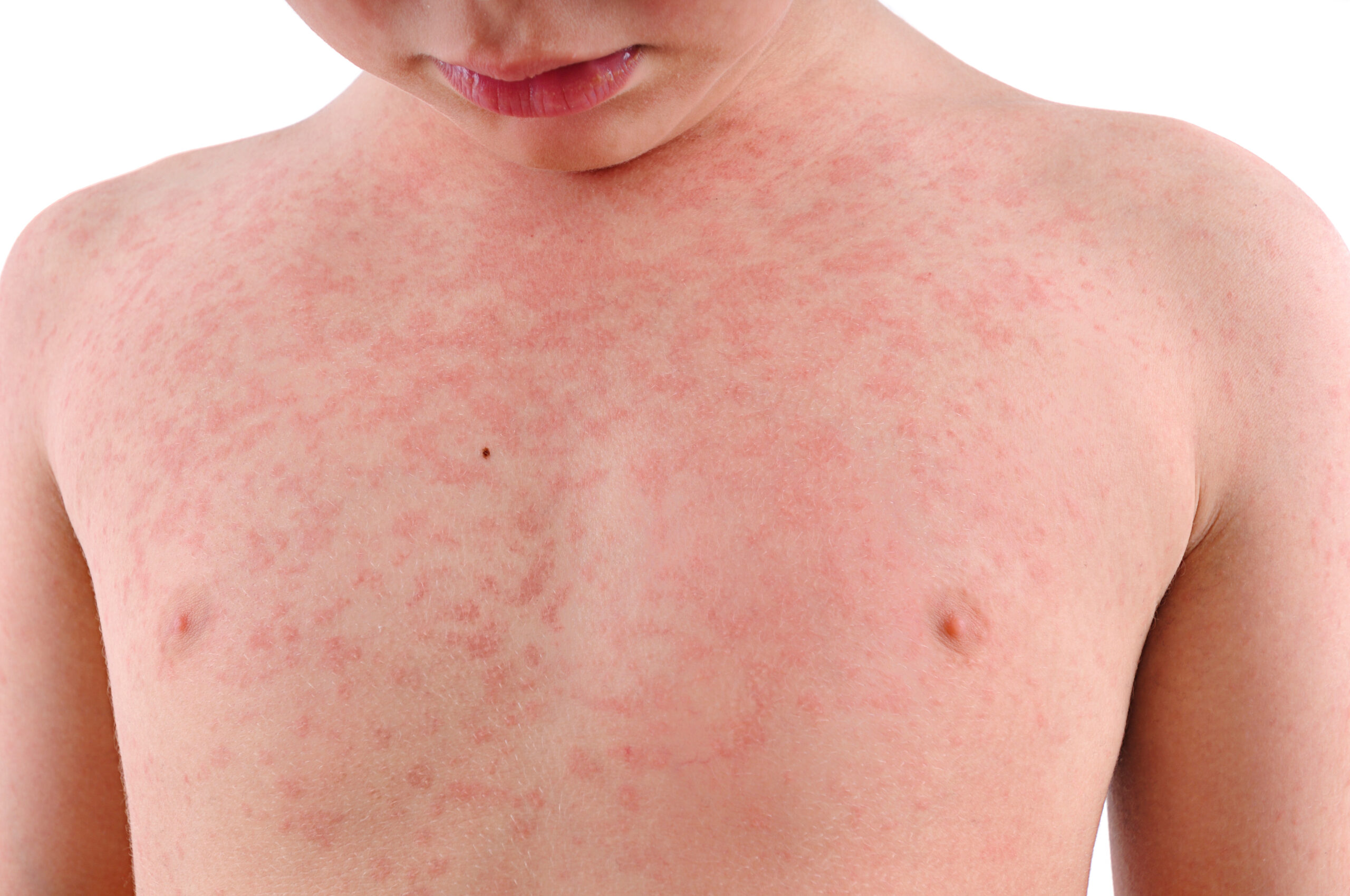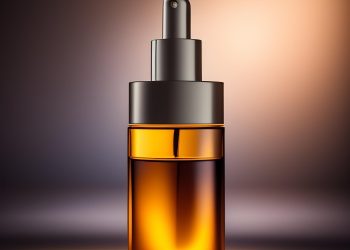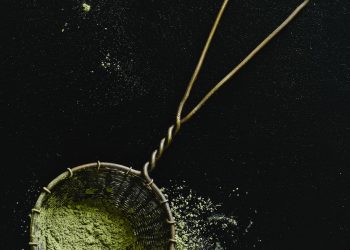Usually, when our body temperatures get high due to heat, we sweat. Sweating is the natural mechanism of the body to remove excess heat and sometimes urea from the body.
Droplets of water mixed with salt and urea come out through the tiny pores of the skin. Usually, these pores are there all over the body. Therefore, sweating can lead to foul odors depending on where it comes from.
Coming back to heat rash, it occurs when these pores through which sweat comes out get blocked. The clogged pores prevent work from evaporating. Friction and these blocked pores of the skin results in the formation of small red bumps. These bumps are often spiky and itchy [1, 2].
We call these bumps “heat rash .”These bumps often cause a lot of problems. The other name for heat rash is miliaria [1].
As problematic as they are, these painful blisters may appear on the parts of the body that rub together. These body parts include the inner thighs, under the arms, necks, armpits, and elbows [2].
But don’t worry. Some home remedies can help you get rid of heat rash.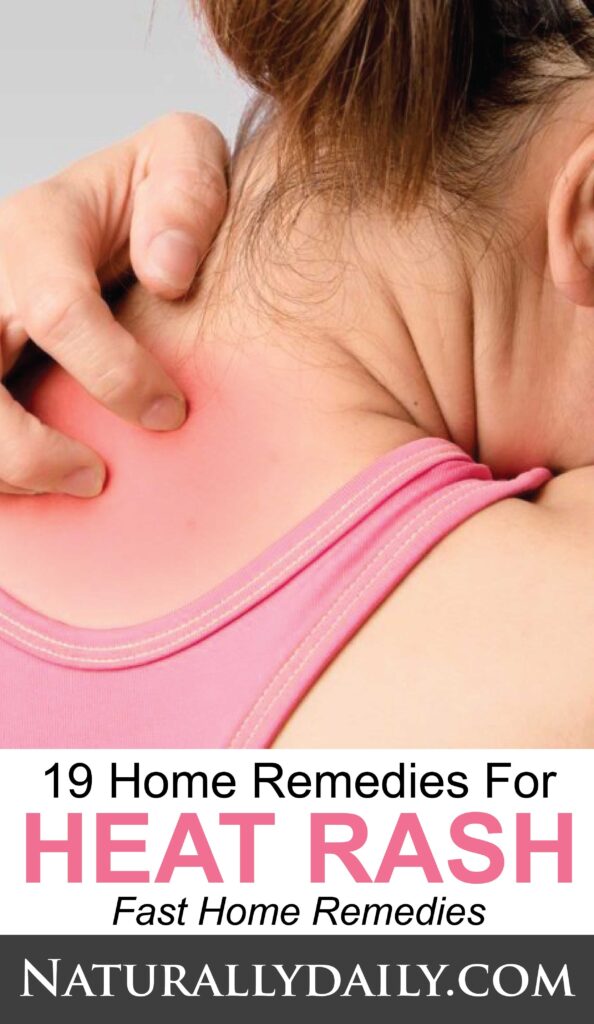
How Does Heat Rash Affect You?
Heat rash can affect almost anyone of all ages.
But, the typical victims of heat rash are usually babies and children. They do not have developed sweat glands.
Also, those living in hot and humid locations and conditions are prone to getting heat rash.
Plus, people who are overweight and obese also can suffer from heat rash [2].
Heat rashes usually go away by themselves after a few days.
But, there are cases where the heat rash is not so severe, but the rashes are still very itchy and painful.
So, if you have such heat rashes and need immediate relief, you can try using these home remedies for heat rash.
19 Natural Remedies for Heat Rash
1. Oatmeal
Oatmeal – is a great way to start the day. Having good nutritious value, it is one of the perfect choices for many at breakfast.
It is not only the nutritious value that is great about oatmeal. It is rich in vitamin B, E, minerals, and soluble fiber. Oatmeal is also an excellent way to maintain skin health [4].
For many years, it has been treating psoriasis, atopic dermatitis, etc. [5]
Oatmeal has cleansing, moisturizing, soothing, and anti-inflammatory properties. Thus, it can also work for minor skin problems like heat rash [6].
Its cleansing activity is due to saponins. Its anti-inflammatory, anti-itch, and anti-irritant actions are because of avenanthramides [6, 7].
Researchers recommend cooling oatmeal baths for people with heat rash [8].
How to use oatmeal for heat rash:
Put oatmeal in a food processor or blender. Grind it until it turns into powder. Fill the tub with cool water. Add oatmeal powder. Use your fingers to blend oatmeal powder and water. Sit in the bath for 30 minutes. Dry your body using a towel made of soft fabric. Use this remedy twice a day for one week.
2. Aloe Vera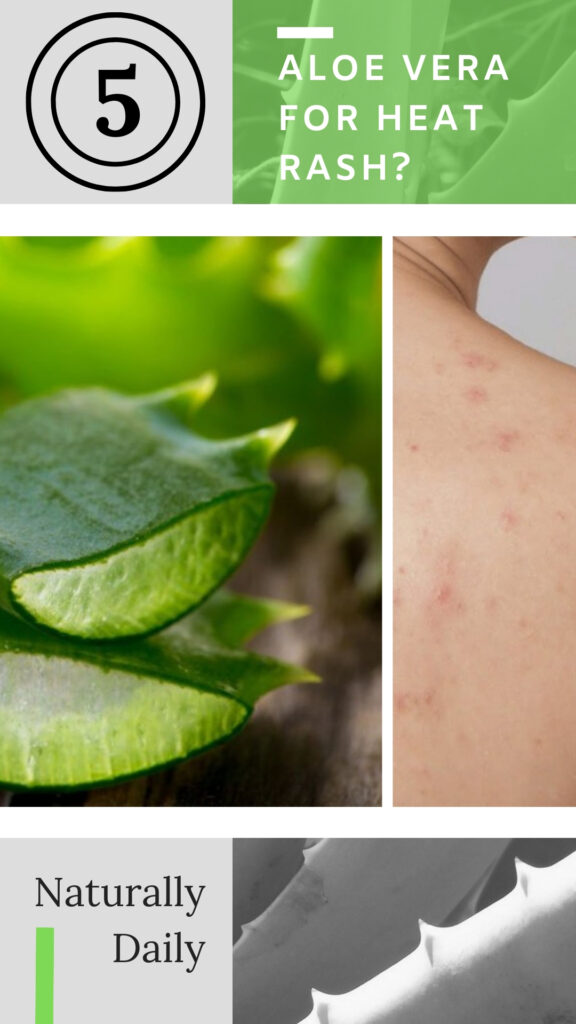
Who would think that a cactus-like plant like aloe vera would have so many benefits for health?
Traditional healers have been using aloe vera since as early as 333 BC. They took advantage of its ability to heal burns and wounds [9].
There’s scientific evidence to justify the folkloric use of aloe vera as a skin remedy. Because it has a polysaccharide, it forms a soothing and protective barrier when applied to the skin [9].
It’s also a potent anti-inflammatory agent, as reported in various studies [10, 11, 12].
Aloe vera gel can inhibit swelling of the skin and, at the same time, promote the healing of wounds and lesions [12].
There’s no substantive study proving aloe vera’s efficacy on heat rashes. But, it works for this particular skin problem. All these mechanisms are enough to convince many about that.
A simple way to use aloe vera gel for heat rash:
Slice the aloe vera leaf into two. Extract the gel by squeezing the leaf. Apply gel to heat rash. Wait for 20 to 30 minutes. Take a cold shower. Pat yourself dry using a clean and soft towel. Repeat procedure twice daily for up to one week.
Read More: 11+ Health Benefits of Aloe Vera Oil (Backed by Scientific Evidence)
3. Cucumber with Lemon Juice
Cucumber is a prime component in many salads. It is a vegetable with a lot of water and essential minerals. These components can recharge and hydrate you. Its beneficial properties are sky-rocketing.
Beauticians use cucumber slices when using face packs and face masks. Why do they do it? To remove puffy eyes!
So, when you have puffy eyes, get a cucumber, slice it into small pieces, and put it on your eyes. The next thing you know, you will look and feel refreshed and rejuvenated.
Skin rejuvenation is one of the cucumber’s many gifts. Because it has cooling, moisturizing and anti-sebum secretion effects [13]. Thus, cucumber is an excellent remedy for heat rash.
One of its best abilities is to reduce erythema or reddening of the skin. What it does is reverse the increased flow of blood in the skin. A 2011 study confirmed it [13].
Cucumber also has a soothing effect that alleviates skin irritation and inflammation. It also relaxes and nourishes the skin [14].
Learn how you can use cucumber and lemon juice for heat rash:
Slice 1 cucumber. Put cucumber slices in a bowl of cold water. Add 2 tablespoons of lemon juice. Lay cucumber slices on heat rashes for 10 minutes. You can blend the cucumber slices and apply the pulp to the skin if you’d like. Wash off cucumber with cool water. Do this three times a day for one whole week.
Read More: 12 Benefits of Cucumber Water and how to make it
4. Fuller’s Earth
Many moms rely on fuller’s earth for treating their babies’ heat rashes.
It’s not established as a heat rash solution. But it can relieve itching, irritation, and inflammation of the skin.
A clinical review of an herbal face pack includes fuller’s earth as one of the key ingredients. In addition, the study mentions that it can remove impurities and reduce skin irritation [15].
It also has a cooling mechanism that reduces inflammation in babies with heat rash [15].
How you can treat your heat rash using fuller’s earth:
Combine 5 tablespoons of fuller’s earth with 3 tablespoons of rose water to form a paste. Spread a thin layer of this paste on top of the heat rashes. Wait for it to dry before rinsing with cold water. You can practice this remedy once a day for one week.
5. Lavender Essential Oil
Lavender essential oil is one of the most popular aromatic oils in the world. This super calming oil originates from the flowers of lavender flowers—the native of this essential oil in the Mediterranean region.
Using lavender oil for heat rash can flush accumulated toxins off your pores and ease the itch. It can also inhibit inflammations from developing. In addition, the lavender essential oil contains powerful disinfectants, antioxidants, antimicrobial, anti-inflammatory, and soothing properties. Thus, lavender oil is your ultimate solution to eliminate heat rash.
Envato
Here’s how you may use lavender oil to get rid of heat rash:
First, mix 8-10 drops of lavender oil into your mild warm bath water. Soak in the water completely for about 20 minutes. Lavender oil gets absorbed into your skin very fast. Thus, it can relieve the irritations and heal the skin inflammations. Repeat the calming aromatic oil bath daily before you go to sleep to recover the heat rash fast.
Read More: 11 Health Benefits of Lavender Oil That You Should Know
6. Margosa Leaves
Also called neem leaves, margosa leaves are another practical remedy for heat rash.
These leaves come from a tree that’s native to Southeast Asia. It could treat skin ulcers, gastrointestinal ailments, malaria, and infections [16].
It was also common for people to bathe in neem water. This is because it could ease skin problems like boils and heat rashes. Because it has antiseptic and antibacterial properties [16].
A team of Indian researchers used neem leaves to create an anti-heat rash cotton fabric [17].
The fabric treated with neem leaf extract reduced bacterial infection by up to 100% [17].
How to use margosa leaves for heat rash:
Use a food processor or blender to grind neem leaves until the consistency is like a paste. Smear paste on affected areas of the body. Let it dry. Wash it off with cool water. Follow this technique once a day for one week.
7. Cold Compress
Many people rely on this ancient household remedy for pains and inflammation.
Cold water, as it turns out, has a healing effect on the skin [18].
It speeds up recovery from wounds, burns, and other skin ailments, including heat rash [18].
Not only does it tones down swelling, but also it cools and moisturizes the skin. Thus it reduces the appearance of skin bumps and blisters and relieves itching.
Because it’s straightforward to put together, you can use this home remedy anytime you need it.
An easy way to soothe heat rash using a cold compress:
Wrap ice cubes in a towel. Place it on top of heat rashes for 10 minutes, then take a short break. Repeat until you’ve covered all affected areas. Do this every five hours for two to three days. This will relieve itching and redness. It will also help prevent rashes from spreading. If you don’t have ice cubes, use cold water and soak a towel. Squeeze water from the towel and apply it to the rashes. Repeat as often.
8. Sandalwood
Sandalwood is famous for its analgesic, antioxidant and anti-inflammatory properties [19].
Sandalwood is famous for its beautifying properties as well.
It has always been among the go-to solutions for fever, headache, and swelling [19].
For those with heat rash, sandalwood powder can also help.
This powder can reduce body temperature. Therefore, it is essential for quick recovery. It can also reduce inflammation, a typical symptom of heat rash [20].
Its oil extract can relieve itching and hydrate the skin [21].
Using sandalwood powder on your skin helps you get rid of annoying rashes. It also keeps the skin from drying out.
Learn how to use sandalwood for heat rash:
Mix 1 tablespoon of sandalwood, coriander powder, rose water, and 1 drop of sandalwood oil. Apply the paste to the affected skin. Leave it on for a few minutes as it dries. Rinse with cold water. Do this procedure twice a day for one week.
9. Baking Soda
Baking soda has countless uses for the home and health that never fails to amaze anyone.
It’s used as an ingredient in pastries and a natural household cleaner. But unfortunately, it’s also an effective bleaching agent.
Baking soda is another fantastic solution for heat rash because it acts as a gentle exfoliant to eliminate dead skin cells and dirt and unclog the pores.
This is an effective way to ease inflammation and itching.
Many studies and books have documented its use for this particular skin problem [22, 23].
Try this baking soda recipe to get rid of heat rash:
Combine 1 tsp of baking soda and a cup of cold water. Soak a soft cloth into the solution. Wring the material to get rid of excess liquid. Pat cloth on heat rashes for 10 minutes. Practice this remedy twice a day for one to two weeks.
Read More: Baking Soda for Acne: 12 Easy Ways You Can Use
10. Calendula
Let’s not forget about the calendula flower.
Although it’s not the first remedy on people’s minds when it comes to heat rash, it’s one of those that work.
Several studies confirm that calendula is a potent anti-inflammatory. In addition, it reduces swelling on the skin due to rash infections [24, 25].
Calendula can inhibit pro-inflammatory cytokines in the body [25].
When you use it, you’ll notice that it has a soothing and cooling effect on the skin.
Try this calendula flower bath to get rid of heat rash:
Add 1 cup of calendula flowers to your bath water. Let it sit for 30 minutes. Then, soak in the bath for another 30 minutes. Finally, rub water on heat rashes. Repeat the process once a day for one week.
11. Gram Flour
Gram flour has many names: garbanzo bean flour, chickpea flour, and besan.
It’s a potent remedy for all conditions, including minor ones like heat rash.
Using dry powder such as gram flour is good for stimulating lymph actions. It also promotes detoxification and removes impurities from the skin [26].
It’s suitable for drying, cleaning, disinfecting, and rejuvenating skin with heat rash [26].
A simple way of using gram flour for heat rash:
After bathing, dry your body with a clean, soft towel. Sprinkle gram flour on top of heat rashes. Leave it on for the rest of the day. Repeat the next day. Do this for one week.
12. Cucumber
Cucumber is the first thing you think about when you need to get rid of puffy eyes.
Yes, this is the most popular use of cucumber for skincare, but it’s one of its many applications.
You can also apply cucumber to heat rashes to soothe irritation and swelling.
It has cooling effects that benefit those with heat rashes and sunburn [27].
It also has an intense cleansing action that removes dirt and impurities [27].
This means that you won’t only relieve heat rashes, but you’ll also nourish your skin and keep it soft and supple.
Unsplash
How to use cucumber for heat rash:
Grate cucumber and put it in a bowl. Spread a thick layer of cucumber shreds on heat rashes. Let it sit for 15 minutes. Rinse with cool water. Repeat three times a day until heat rashes disappear.
13. Watermelon
Like cucumber, watermelon also has cooling effects when applied to the skin.
It’s because this fruit is also high in water content. For example, watermelon is made of 92 percent water [28].
When you’re bothered by heat rashes, you can use this watermelon remedy for comfort and relief.
Those who have tried using watermelon for this problem have reported significant improvement.
Here’s how you may use watermelon for heat rash:
Put 1 cup of watermelon cubes in a blender. Blend until the consistency is like a smoothie. Put in the refrigerator. Chill for two to three minutes. Apply to heat rashes. Wait for 10 to 15 minutes before rinsing with cool water. Repeat the procedure twice a day until you heal.
14. Peppermint Essential Oil
Peppermint essential oil comes from the evergreen peppermint herbs. The medical use of its leaves and oil dates back to ancient Egyptian civilization.
Peppermint oil has extensive use in the cosmetic and medical industries. It contains anti-inflammatory omega-3 fatty acids, vitamins, and antifungal properties. [29] 
These potent agents soothe your nervous system and treat a heat rash and swellings.
Peppermint oil has cooling effects because of menthol. Its topical application of it boosts blood circulation and prevents contractions of muscles. Moreover, the peppermint oil remedy is cheaper and more comfortable than prescription drugs. [30]
How you can soothe your heat rash using peppermint oil:
First, add 3-5 drops of peppermint oil to ½ cup of distilled water, shake, and mix. Next, pour the solution into a spray bottle. Now, spray the cooling solution to the rash-affected skin throughout the day.
Read More: 12 Health Benefits of Peppermint Oil + (How to Use It)
15. Dandelion
Dandelion is a medicinal herb. Dandelion roots are potent with therapeutic values.
Dandelion is an effective remedy for stomach disorders, skin rashes, eczema, etc. [31]
Dandelion is a traditional laxative that helps urine production and regulates bowel movements.
Moreover, dandelion is a skin toner, anti-viral and anti-cancer agent.
One of the reasons that aggravate heat rash is water retention. Dandelion is a natural diuretic agent with high potassium and mineral values. These properties can regulate production and flush out the urine from the body. [32]
A simple dandelion root recipe for heat rash:
Add 1 tsp of dandelion tincture to 2 cups of lukewarm water. Drink this potion twice daily to soothe the heat rashes.
16. Stinging Nettle
Stinging nettle or Urtica dioica is a flowering plant from the Urticaceae family. This medicinal plant grows in Asia, Europe, North America, and Northern Africa.
People have been using different parts of the nettle plant for thousands of years. Some of the uses of nettle are relieving anemia, rheumatism, heat rash, kidney problems, etc. [33]
You can use the leaf, root, extracts, tinctures, and nettle supplements to curb heat rash.
Nettle is a diuretic like a dandelion. It can flush out the excess fluid and toxins in the body through urination. Thus, it helps prevent water retention.
Moreover, stinging nettle works as a natural antihistamine agent. People use it to relieve allergic reactions, rashes, and skin inflammations
. [34]
In the medical store, you can get dried leaf extracts, tinctures, and supplements in tablet form.
Learn how you can use nettle leaf to soothe your heat rash:
You can apply the nettle tincture to your affected skin using a cotton ball. Or, boil 1 tsp of dried extracts in a cup of water and drink the potion twice daily.
17. Ginger
Ginger’s usage as a medicinal plant for the treatment of diseases dates back to ancient times.
It helps against inflammation. It also treats a wide range of other diseases such as diabetes, cardiovascular disease, etc., to name a few.
Ginger also helps reduce itching and stinging sensation caused by heat rash.
Some of ginger’s active components help it exhibit such unique properties. Thus, they make it highly beneficial in treating heat rash as well.
How to use ginger for heat rash:
Grate a small piece of fresh ginger and boil it in water. Once the water cools down, using a clean and soft cloth, dab your affected skin with this ginger solution. Keep it on for 10-15 minutes. Then, rinse it off with plain water. Repeat this procedure twice a day for effective results.
Read More: 10 Health Benefits of Ginger Oil That You Should Know About
18. Olive Oil
Olive oil is one of the best natural remedies for heat rash. You can apply this mild oil to treat heat rash on the neck and face. Some researchers have confirmed its exceptional benefits for your skin health.
Olive oil contains antioxidants, vitamin E, and other skin rejuvenating properties. In addition, you can massage olive oil on the heat rash to quicken the healing process and calm the irritations. It can also prevent rashes.
Here’s how you may use olive oil for heat rash:
Mix 1 tablespoon of turmeric powder with ½ tsp of olive oil. Apply the mixture to your heat rash-affected areas. Turmeric powder will help reopen the clogged pores and flush out toxins. In addition, olive oil will provide a soothing sensation against itchiness. Repeat the treatment 3 times daily.
Read More: Olive Oil for Skin Health Boost (How to Use)
19. Epsom Salt
Epsom salt is a perfect home remedy for relieving muscle aches, pains, and irritations. It also disinfects the body. Epsom salt originates from the natural saline springs of Epsom in England.
Epsom salt bath is the traditional remedy for many skin disorders. The magnesium sulfate in Epsom salt helps to release the harmful toxins and dirt off the skin cells. It can also treat the itch, blisters, and other symptoms of a heat rash.
Try this Epsom salt bath to soothe heat rash:
Pour 1 cup of salt into your tub filled with lukewarm water. Dip yourself entirely in the rejuvenating solution for about 15-20 minutes. Once you are out of the tub, tap to dry your skin with a fresh towel. Repeat the treatment every alternate day until the heat rash subsides.
When to See a Doctor
It is always a good idea to go to the doctor and get a proper checkup if you have a heat rash.
Also, if any of your family members, like your baby, are suffering from heat rash, you must go to the doctor. Because they are young, their condition can worsen at any time. So it is best to be well-prepared.
Usually, a heat rash goes away on its own within 3-4 days. But if a heat rash stays for more than a week or 10 days, it’s better to consult a doctor.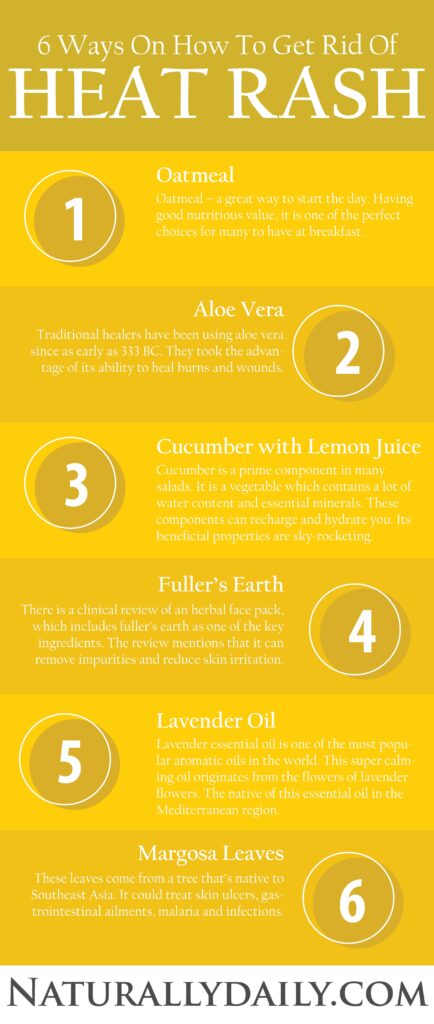
Conclusion
There’s no reason to panic when you have heat rashes.
You can rely on these natural remedies to get rid of heat rash and the immediate comfort you’re looking for.
And don’t hesitate to consult your doctor if the heat rash has become a chronic condition.
We hope this article came to your help; if you have any questions or confusion about it, feel free to ask us.
Also, don’t forget to share your experience with us by leaving your comments below.
Read Next: Coconut Oil for Diaper Rash: 5 Easy Home Remedies
